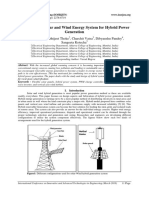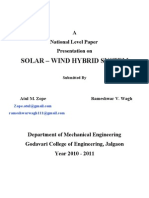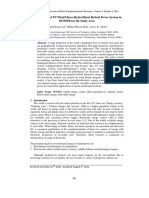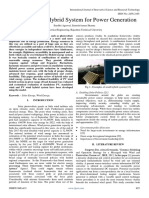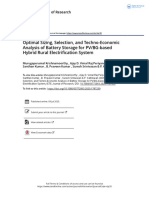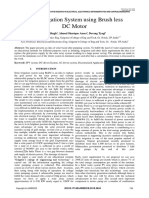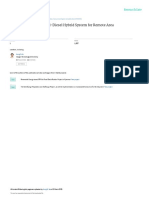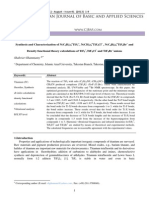Cjbas 13 01 01 03
Cjbas 13 01 01 03
Uploaded by
CJBAS ManagerCopyright:
Available Formats
Cjbas 13 01 01 03
Cjbas 13 01 01 03
Uploaded by
CJBAS ManagerOriginal Title
Copyright
Available Formats
Share this document
Did you find this document useful?
Is this content inappropriate?
Copyright:
Available Formats
Cjbas 13 01 01 03
Cjbas 13 01 01 03
Uploaded by
CJBAS ManagerCopyright:
Available Formats
CJBAS Vol.
(01) - August - Issue 01 (2013) 19-25
Rural Electrification System based on Hybrid Energy System Model Optimization using
HOMER
Nitin Vania and Vikas Kharea,
a
Department of Electrical & Electronics Engineering, VITS, MITM, Indore 452001
Keywords:
Solar/Wind System,
Hybrid energy system,
renewable sources,
HOMER Software
Abstract
Hybrid energy power system is built in many rural areas where the limited nonconventional energy sources are available due to higher transportation cost. Higher
maintenance cost is one of the most reasons for diesel generators are very expensive
for this area. This paper investigates cost and size optimization model for hybrid
(solar, wind and diesel) power system demonstrate with Hybrid Optimization for
Electric Renewable (HOMER) software. We present hybrid power system contain
solar, wind and diesel power generation with battery storage for Jamnya Van village
dist. Barwani in Madhya Pradesh, India. System designed based on site empirical
weather and load data. We optimize a problem to minimize total net present cost,
operating and running cost of the hybrid system.
1. Introduction
Global resources of fossil and nuclear fuel are limited, while requiring search for alternate sources
of energy. Hybrid technology is one of the growing technologies during these days. Hybrid systems
are continuously challenged to provide reliable services to rural and remote areas where there is no
efficient electrical power supply available. Therefore, renewable energy systems are becoming
progressively popular in that area to provide reliable and efficient power to remote areas. [1]
Seasonally variations of wind speed and solar radiation resources are complementally to each other.
Status and future prospective effect of Wind energy in India are presented and discussed [2].
India is a remarkably occupied country in all around the world and hence its energy demand is also
more and increasing with time. In most countries Indian states it is not easy to satisfy power
demand all year extended by hydro sources alone. Hence it is essential to interconnect other
renewable energy sources for dependability and consistence power supply. Renewable energy
sources offer a viable alternative to the condition of power in rural areas [3-7].
In Madhya Pradesh electricity is generated mostly by using hydro electric power station & thermal
power system. The generated electricity is not fulfilling the demand of electricity consumption.
Therefore electricity generation by the help of renewable sources such as the solar & wind power is
the most power full tools for fulfilling the demand of electricity consumption. Village Jamnya
Corresponding author (E-mail: vikaskhare09@yahoo.in).
19
Nitin Vani and Vikas Khare CJBAS Vol. (01)-August Issue 01 (2013) 19-25
Van dist. Barwani in Madhya Pradesh found
under the rural area where the population is
about 120 with 22 small houses and electricity
supply is very limited and at maximum period
of time one can encounter the power cutoffs.
The proposed system examined under the
paper overcomes the high power cutoff
problems
by
providing
a
renewal
uninterrupted power supply system for the
daily household purpose with agricultural as
well as basic domestic general purpose.
Hybrid power systems are seen as a way to
provide power to the many remote
communities in the developing world where
the costs for large scale expansion of electrical
grids are prohibitive and the transportation
costs of diesel fuel are also very high.
Continuous consumption of fossil fuels, such
as oil and coal, energy shortage in the
battery,
environmental
pollution
and
ecological deterioration are becoming
severe every day. Utilization of renewable
energy is an effective way to solve the
energy crisis and environmental pollution
problems [8].
The proposed system defined on the basis of
the village contains a minimal population of
all around hundred whose only source of
income is agriculture. This paper focuses on
reliable and efficient hybrid system integration
of PV/WT hybrid system. In the last few years
the world is experiencing higher prices of oil,
which had caused several oil crises since early
1970s. Also, the world is experiencing many
environmental issues related to usage of fossil
fuel. For these reasons, the research and
developments have increased to use renewable
energy for generating power. [8], [9], [10],
[11]. Several literature references have
discussed on sizing and to decide the optimum
combination of a hybrid energy system [7, 13,
14]. A lot of presents a comparison study to
conclude the optimal configuration of power
sources applicable to different regions [4].
HOMER software means Hybrid Optimization
Model for Electric Renewable [15, 16].
2. Proposed system
Size optimization of hybrid system is done by
optimization model for electric renewable
software (HOMER). The proposed system
contains solar power, wind power with diesel
generator with battery storage system for
storage of excess generated electricity.
Converter system connected between AC and
DC link. The wind turbine is the major
supplier of energy to this system and the
variation of wind power with time, together
with the household demand, are the only
outside variables influence the system. The
PV systems with battery banks share some of
the loads. The diesel generators and battery
banks are used as a back-up electricity source
[16, 17]. The HOMER software determines
optimal cost and sensitivity analysis of the
proposed system. Firstly we describe a model
configuration of the hybrid energy system that
consists of Photovoltaic module system, wind
turbine System, Diesel generator system and
the battery storage system as our work space
shown in the Figure 1.
Figure 1. Hybrid Energy System in HOMER
3. System load data
Village Jamnya Van dist. Barwani in Madhya
Pradesh daily average electricity consumption
is 70 kWh/day. Solar radiation, wind speed
and load data obtain from the government
serve in 2011-12 under the guidance of Janpad
Panchayat Niwali Dist. Barwani (M.P.).
Figure 2 shows the typical load profile for the
20
Nitin Vani and Vikas Khare CJBAS Vol. (01)-August Issue 01 (2013) 19-25
village site produce by the HOMER software.
Per hours load variation mainly due to the
running of the water pump used in the
agricultural industry.
system is 6.5 kW with is obtained from total
10 strings. Each string contains 2 modules.
The details of STP280 module by Suntech is
as following
Figure 2. Daily Load Profile for the Site Data
Figure 3. Current-Voltage and Power-Voltage
Curve (280-24)
4. Photovoltaic module system
STP280 solar module used in this system
which provide 280 W powers output with 24
V. This is most reliable solar power module
for on and off grid residential and commercial
system. When to modules are connected in
series thus equivalent output voltage is equal
to the sum of the voltage individually i.e. 48 V
bus for this system. Total Capacity of the PV
Excellent performance under weak light
conditions: at an irradiation intensity of 200
W/m2 (AM 1.5, 25OC), 95.5% or higher of the
STC efficiency (1000 W/m2) is achieved. The
initial and replacement cost of the two
modules connected in series are $1600 and
$1540 respectively.
Table1. Shows the temperature characteristics of the cell
Nominal Operating Cell temperature (NOCT)
Temperature Coefficient of Pmax
Temperature Coefficient of Voc
Temperature Coefficient of Isc
Operation and maintenance cost of the
modules connected in proposed system is $10.
The latitude and longitude of the village
45+-2oC
-0.44 % /OC
-0.33%/oC
0.055%/OC
Jamnya Van Site is 22.7195687 and
75.8577258 respectively. The effective time
zone of the India is GMT+ 05.30.
21
Nitin Vani and Vikas Khare CJBAS Vol. (01)-August Issue 01 (2013) 19-25
Table 2. show the baseline data used for global horizontal radiation.
Months
Clearness Index
Daily Radiation
(KWh/m2/d)
Jan
0.684
4.810
Feb.
0.697
5.650
March
0.675
6.350
April
0.668
6.990
May
0.656
7.210
June
0.546
6.080
July
0.432
4.770
August
0.393
4.170
September
0.533
5.190
October
0.684
5.790
November
0.675
4.900
December
0.675
4.510
Average
0.598
5.531
Turbine capital and replacement cost are
$22490 and $18000 respectively. Operation
and maintenance cost as $462 per years. The
hub height selected of 30 meters from the
earth surface. The curve between wind speed
and power generated shown in Figure 6.
5. Wind turbine system
BWC Excell-R/48 wind turbines are used for
proposed system having rated capacity of 7.5
kW. BWC Excell-R/48 modern wind turbine
heaving 7 meters (32 ft.) diameter for
reliability, low maintenance and automatic
operation in adverse weather conditions.
Figure 6. Wind Speed-Generated Power Curve
Figure 4. Global horizontal Radiation curve
6. Converter system
Here converter is used which can work both as
an inverter and rectifier depending on the
direction of flow of power. A converter is used
to convert and maintain power flow between
DC and AC link. According to the load profile
used for proposed system 5 kW converter are
used. The operation cost for such type of
converter is $2300 and replacement cost is
Figure 5. Scaled data profile generated
22
Nitin Vani and Vikas Khare CJBAS Vol. (01)-August Issue 01 (2013) 19-25
$2300. We assume maintenance free converter
system.
Table 3. shows the wind speed data for the selected site.
Month
January
February
March
April
May
June
July
August
September
October
November
December
Annual Average
According to the base line data wind resources
curve shown in the Figure 7.
Wind Speed(m/s)
4.794
5.702
3.338
4.121
4.062
2.664
3.572
3.630
3.594
4.823
6.587
7.195
4.500
8. Diesel generator system
Diesel generator is used for proposed system
has rated capacity of 5kW and rated speed is
1800 rpm. Generator delivers AC. The capital
cost and replacement cost of the generator are
$16308 and $13590 respectively. The
operation and maintenance cost of the
generator is $0.1/hr. Diesel can be transported
between nearest pump to site by road. There
for the transportation cost of the diesel is
approximately $0.5/liter. When hybrid energy
system generate sufficient amount of power
diesel generators work as a backup for the site.
7. Battery storage system
The variation of solar and wind energy
generation do not competition the time sharing
of the demand. Therefore, power generation
systems need of battery storage facility to
smooth the time distribution disparity between
the load and solar/wind energy generation and
to account for maintenance of the systems.
L16P batteries bank are used for the proposed
site. Each battery has a rated capacity of 6V,
360Ah and generated 2.16 kWh power. The
Capital cost and replacement cost are $2500
and $1500 respectively. Five numbers of
batteries can be used for optimal design of the
hybrid system.
9. Otimization result
Software performs various simulations to
determine best optimal set of configuration of
hybrid energy system. Variation is also done
by using sensitivity variable line solar
radiation, wind speed and prices of oil. Total
32 system configuration examines by the
software and provides three best optimal set of
configuration.
Best
optimal
set
of
configuration contains solar power, wind
power and diesel generator with battery
Figure 7. Wind Resources Data
23
Nitin Vani and Vikas Khare CJBAS Vol. (01)-August Issue 01 (2013) 19-25
storage system for the proposed site. Total net
present cost of the optimal set is $181,847
which is less than two other best optimal set
results. Operating cost per year is also less as
compared to the other test result. According to
the initial and capital cost best optimal set of
configuration contains solar, diesel with
battery storage system. Electricity production
is done by solar PV array is 31% with wind
electricity generation and diesel electricity
generation are 35% and 34% respectively.
Journal of Renewable and Sustainable
Energy, 1, 2 (2009).
DOI: 10.1063/1.3156003
[3] Kanase-Patil A. B., Saini R. P., Sharma M.
P.: Integrated renewable energy system
for off grid rural electrification of remote
area. Renewable Energy, 35, 342-1349
(2010).
DOI: 10.1016/j.renene.2009.10.005
[4] Rajoriya A., Fernandez E.: Sustainable
energy generation using hybrid energy
system for remote hilly rural area in India.
International Journal of Sustainable
Engineering, 3, 219-227 (2010).
DOI: 10.1080/19397038.2010.484870
Figure 8. Optimization Result
[5] Gupta A., Saini R. P., Sharma M. P.:
Steady-state modelling of hybrid energy
system for off grid electrification of
cluster of villages. Renewable Energy,
35, 520-535 (2010).
DOI: 10.1016/j.renene.2009.06.014
Figure 9. Monthly Average Electrical
Production
[6] Setiawan A. A., Zhao Y., Nayar C. V.:
Design,
economic
analysis
and
environmental considerations of mini-grid
hybrid power system with reverse osmosis
desalination plant for remote areas.
Renewable Energy, 34, 374-383 (2009).
DOI: 10.1016/j.renene.2008.05.014
[7] Akella A. K., Sharma M. P., Saini R. P.:
Optimum utilization of renewable energy
sources in a remote area. Renewable and
Sustainable Energy Reviews, 11, 894908 (2007).
DOI: 10.1016/j.rser.2005.06.006
Figure 10. Cash Flow Summary
References:
[1] Larsen K.: Smart grids-a smart idea.
renewable energy focus, 10, 62-67
(2009).
[8]
[2] Purohit I., Purohit P.: Wind energy in
India: Status and future prospects.
24
Zahedi A.: “Energy, People,
Environment”. Development of
an integrated renewable energy and
Nitin Vani and Vikas Khare CJBAS Vol. (01)-August Issue 01 (2013) 19-25
energy storage system, an uninterruptible
power supply for people and for better
environment. in Systems, Man, and
Cybernetics, 1994. Humans, Information
and
Technology.,
1994
IEEE
International Conference on. (1994).
DOI: 10.1109/icsmc.1994.400279
Engineering
and
Optimization
Conference
(PEOCO),
2010
4th
International. (2010).
DOI: 10.1109/peoco.2010.5559240
[13] Razak J. A., Sopian K., Ali Y., Alghoul
M. A., Zaharim A., Ahmad I.:
Optimization of PV-wind-hydro-diesel
hybrid system by minimizing excess
capacity. European Journal of Scientific
Research, 25, 663-671 (2009).
[9] Belfkira R., Nichita C., Barakat G.:
Modeling and optimization of wind/PV
system for stand-alone site. in Electrical
Machines, 2008. ICEM 2008. 18th
International Conference on. (2008).
DOI: 10.1109/icelmach.2008.4799898
.
[10] Lagorse J., Giurgea S., Paire D.,
Cirrincione M., Simoes M. G., Miraoui
A.: Optimal Design Analysis of a StandAlone Photovoltaic Hybrid System. in
Industry Applications Society Annual
Meeting, 2008. IAS '08. IEEE. (2008).
DOI: 10.1109/08ias.2008.132
[14] Alganahi H. S., Haidar A. M., Abdalla
A.: Experimental study of using
renewable energy in Yemen. Australian
Journal of Basic and Applied Sciences, 3,
4170-4174 (2009).
[15] Lilienthal P., Flowers L.: HOMER: The
Hybrid
Optimization
Model
for
Electric Renewable. in Proc. Wind power
'95, American Wind Energy Association,
Washington, DC, 475-480. (1995)
[11] Hung-Cheng C., Jian-Cong Q., Chia-Hao
L.: Dynamic modeling and simulation of
renewable energy based hybrid power
systems. in Electric Utility Deregulation
and
Restructuring
and
Power
Technologies, 2008. DRPT 2008. Third
International Conference on. (2008).
DOI: 10.1109/drpt.2008.4523887
.
[16] Prasad R.: A case study for energy output
using a single wind turbine and a hybrid
system for Vadravadra Site in Fiji
Islands. The Online Journal on Power
and Energy Engineering (OJPEE), 1,
22-25 (2010).
[17] Ibrahim M. Z., Zailan R., Ismail M.,
Muzathik A. M.: Pre-feasibility study of
hybrid hydrogen based energy systems
for coastal residential applications.
Energy Research Journal, 1, 12 (2010).
DOI: 10.3844/erjsp.2010.12.21
[12] Razak N. A. b. A., bin Othman M. M.,
Musirin I.: Optimal sizing and
operational strategy of hybrid renewable
energy system using homer. in Power
25
You might also like
- Mazda I-EloopDocument9 pagesMazda I-EloopeXtremeNo ratings yet
- Computer Aided Optimal Sizing of Hybrid Photovoltaic Wind System For Rural Electrification in IndiaDocument11 pagesComputer Aided Optimal Sizing of Hybrid Photovoltaic Wind System For Rural Electrification in IndiaIJERDNo ratings yet
- Design of Cost Effective Independent PowDocument8 pagesDesign of Cost Effective Independent PowShpresim KuchiNo ratings yet
- Fuzzy Logic MPPT Controller With Energy Management System For Solar-Wind-Battery-Diesel Hybrid Power SystemDocument11 pagesFuzzy Logic MPPT Controller With Energy Management System For Solar-Wind-Battery-Diesel Hybrid Power SystemSebastin AshokNo ratings yet
- Integration of Solar and Wind Energy System For Hybrid Power GenerationDocument5 pagesIntegration of Solar and Wind Energy System For Hybrid Power GenerationDeepak sutarNo ratings yet
- Model and Design For The Control of Hybrid Domestic Power SystemDocument8 pagesModel and Design For The Control of Hybrid Domestic Power SystemfazalNo ratings yet
- Optimum Design of A Hybrid Renewable Energy SystemDocument21 pagesOptimum Design of A Hybrid Renewable Energy SystemsahiiiiNo ratings yet
- Cost Effective Hybrid Energy System Employing Solar-Wind-Biomass Resources For Rural ElectrificationDocument8 pagesCost Effective Hybrid Energy System Employing Solar-Wind-Biomass Resources For Rural ElectrificationAnonymous NUn6MESxNo ratings yet
- Solar and Wind Hybrid System For Rural ElectrificationDocument4 pagesSolar and Wind Hybrid System For Rural ElectrificationEditor IJRITCCNo ratings yet
- Hybrid Renewable Energy Design For Rural Electrification in EthiopiaDocument16 pagesHybrid Renewable Energy Design For Rural Electrification in Ethiopianebex12No ratings yet
- Optimal Sizing of A Hybrid Wind/PV Plant Considering Reliability IndicesDocument9 pagesOptimal Sizing of A Hybrid Wind/PV Plant Considering Reliability Indicesawhan0% (1)
- Design and Modelling of Hybrid PV-Micro Hydro Power Generation Case Study Jimma ZoneDocument9 pagesDesign and Modelling of Hybrid PV-Micro Hydro Power Generation Case Study Jimma ZoneDanang KimoNo ratings yet
- Abstract Raj KishanDocument4 pagesAbstract Raj KishanShreya SinghNo ratings yet
- Hybrid Wind Solar Controller SystemDocument8 pagesHybrid Wind Solar Controller Systemfarazahmad759No ratings yet
- Sciencedirect: Tasneem Salih, Yaodong Wang, Marwan Awad Ahmed AdamDocument4 pagesSciencedirect: Tasneem Salih, Yaodong Wang, Marwan Awad Ahmed AdamSagnik SarNo ratings yet
- Ah 33186193Document8 pagesAh 33186193Shakeel RanaNo ratings yet
- Solar-Wind Hybrid System PresentsDocument11 pagesSolar-Wind Hybrid System Presentsprafulla100% (1)
- Optimization of PV Wind Micro-Hydro Diesel Hybrid Power System in HOMER For The Study AreaDocument19 pagesOptimization of PV Wind Micro-Hydro Diesel Hybrid Power System in HOMER For The Study AreaRodrigoNo ratings yet
- Compusoft, 1 (1), 8-12Document5 pagesCompusoft, 1 (1), 8-12Ijact EditorNo ratings yet
- Economic Analysis of A Hybrid Solar-Fuel Cell Power Delivery System Using Tuned Genetic AlgorithmDocument9 pagesEconomic Analysis of A Hybrid Solar-Fuel Cell Power Delivery System Using Tuned Genetic AlgorithmVishnu Kumar NadarNo ratings yet
- Hybrid Power SystemDocument14 pagesHybrid Power Systemdoud98No ratings yet
- Description of HOMER Software - An Optimal Analysis ToolDocument17 pagesDescription of HOMER Software - An Optimal Analysis Toolanon_849607662No ratings yet
- J Energy 2020 118387Document33 pagesJ Energy 2020 118387Rendi EgaNo ratings yet
- Analysis of Wind Diesel Hybrid System by Homer SoftwareDocument4 pagesAnalysis of Wind Diesel Hybrid System by Homer SoftwareEditor IJTSRDNo ratings yet
- RRL FinalDocument3 pagesRRL FinalMaria CamiLa Roxanne ViernesNo ratings yet
- Performance Analysis of Hybrid Model of Wind Mill, Photovoltaic Cell and Fuel CellDocument4 pagesPerformance Analysis of Hybrid Model of Wind Mill, Photovoltaic Cell and Fuel CellShakeel RanaNo ratings yet
- Optimum Design of A Renewable Energy SystemDocument4 pagesOptimum Design of A Renewable Energy SystemkeerthiNo ratings yet
- Efficiency Enhancement in Hybrid Renewable Energy System Using Polycrystalline Silicon CellDocument8 pagesEfficiency Enhancement in Hybrid Renewable Energy System Using Polycrystalline Silicon CellInternational Journal of Applied Power EngineeringNo ratings yet
- Techno Economic Analysis of A PV Wind BaDocument5 pagesTechno Economic Analysis of A PV Wind BaIrfan Ahmad BakhtyalNo ratings yet
- Techno-Economic Analysis of A PV - Wind-Battery-Diesel Standalone Power System in A Remote AreaDocument5 pagesTechno-Economic Analysis of A PV - Wind-Battery-Diesel Standalone Power System in A Remote Areacastilho22No ratings yet
- Balancing Cost and Performance in A PV/Wind/Battery Hybrid Power SystemDocument5 pagesBalancing Cost and Performance in A PV/Wind/Battery Hybrid Power SystemKhubaib AhmedNo ratings yet
- Using Y-Source Network As A Connector Between Turbine and Network in The Structure of Variable Speed Wind TurbineDocument15 pagesUsing Y-Source Network As A Connector Between Turbine and Network in The Structure of Variable Speed Wind TurbineInternational Journal of Power Electronics and Drive SystemsNo ratings yet
- A New Hybrid Photovoltaic-Diesel System Control Scheme For An Isolated LoadDocument12 pagesA New Hybrid Photovoltaic-Diesel System Control Scheme For An Isolated LoadHichem HamdiNo ratings yet
- SolarDocument13 pagesSolar116-Sravan KumarNo ratings yet
- Stability Analysis of Wind-PV-DieselDocument10 pagesStability Analysis of Wind-PV-DieselDaniloNo ratings yet
- Hybrid Energy Systems ThesisDocument8 pagesHybrid Energy Systems Thesislaurenbarkeringlewood100% (2)
- Solar Hybrid PowerplantDocument29 pagesSolar Hybrid PowerplantSulaim Abdul LatheefNo ratings yet
- PV Array Design Worksheet Determine The Array Size For Your Grid-Connected System.Document6 pagesPV Array Design Worksheet Determine The Array Size For Your Grid-Connected System.موج البحرNo ratings yet
- Economic Dispatch For A Microgrid Considering Renewable Energy Cost FunctionsDocument7 pagesEconomic Dispatch For A Microgrid Considering Renewable Energy Cost FunctionsibtihalislamNo ratings yet
- Hybrid Energy Optimization With Battery Energy StorageDocument15 pagesHybrid Energy Optimization With Battery Energy Storage19EE245 RahulNo ratings yet
- Unit 05Document36 pagesUnit 05JayaprakashamNo ratings yet
- SOLARMILLDocument13 pagesSOLARMILLdhiraj dokeNo ratings yet
- Synopsis.h 041604Document4 pagesSynopsis.h 041604Hybrid Power systemNo ratings yet
- Hybrid Power Generation Using Solar and Wind With GSM TechnologyDocument6 pagesHybrid Power Generation Using Solar and Wind With GSM TechnologyrassNo ratings yet
- Modeling and Design of Hybrid Power Plants: Ahmed KH A. E. AlkhezimDocument5 pagesModeling and Design of Hybrid Power Plants: Ahmed KH A. E. AlkhezimIOSRJEN : hard copy, certificates, Call for Papers 2013, publishing of journalNo ratings yet
- Solar ProjectDocument61 pagesSolar Projectwww.sangug06No ratings yet
- A Review On Hybrid System For Power GenerationDocument5 pagesA Review On Hybrid System For Power GenerationInternational Journal of Innovative Science and Research TechnologyNo ratings yet
- The Role of Power Electronics in Renewable Energy Systems Research and DevelopmentDocument5 pagesThe Role of Power Electronics in Renewable Energy Systems Research and DevelopmentNaga Surya PrakashNo ratings yet
- Tailor and Fransis JournalDocument17 pagesTailor and Fransis JournalSuresh SrinivasanNo ratings yet
- Design and Simulation of Grid-Connected PhotovoltaDocument10 pagesDesign and Simulation of Grid-Connected PhotovoltamugahedNo ratings yet
- Accepted Manuscript: EnergyDocument23 pagesAccepted Manuscript: Energyiraj FarajiNo ratings yet
- Wind Solar HybridDocument14 pagesWind Solar HybridmpurperNo ratings yet
- Homer 4Document7 pagesHomer 4Stefan NiculceaNo ratings yet
- Voltage Profile Improvement in A Hybrid Distribution System Using EtapDocument12 pagesVoltage Profile Improvement in A Hybrid Distribution System Using EtapTien Dang ThanhNo ratings yet
- Grid-Connected PV System Case StudyDocument7 pagesGrid-Connected PV System Case StudyHayan JanakatNo ratings yet
- Solar Irrigation System Using Brush Less DC Motor: Renu Singh, Ahmed Sharique Anees, Devang TyagiDocument5 pagesSolar Irrigation System Using Brush Less DC Motor: Renu Singh, Ahmed Sharique Anees, Devang TyagiEdamEdamNo ratings yet
- Optimum Design of Wind-Diesel Hybrid System For Re PDFDocument9 pagesOptimum Design of Wind-Diesel Hybrid System For Re PDFAishraNo ratings yet
- Renewable Energy Committee ReportDocument66 pagesRenewable Energy Committee ReportRodrigo Ghisolfi da Silva100% (1)
- Active Cooling Photovoltaic With IoT FacilityDocument9 pagesActive Cooling Photovoltaic With IoT FacilityInternational Journal of Power Electronics and Drive SystemsNo ratings yet
- Spectroscopic Analysis of Archaeological Pottery Excavated From Alagapuri, Tamilnadu, IndiaDocument9 pagesSpectroscopic Analysis of Archaeological Pottery Excavated From Alagapuri, Tamilnadu, IndiaCJBAS ManagerNo ratings yet
- Cjbas 14 02 01 02Document16 pagesCjbas 14 02 01 02CJBAS ManagerNo ratings yet
- Cjbas 15 03 04 02 PDFDocument8 pagesCjbas 15 03 04 02 PDFCJBAS ManagerNo ratings yet
- The Prevalence of Physical Activity and Sedentary Lifestyle Among Adolescents in PalestineDocument10 pagesThe Prevalence of Physical Activity and Sedentary Lifestyle Among Adolescents in PalestineCJBAS ManagerNo ratings yet
- Modeling Spatial Dstribution of Lantana Camara - A Comparative StudyDocument18 pagesModeling Spatial Dstribution of Lantana Camara - A Comparative StudyCJBAS ManagerNo ratings yet
- Cjbas 14 02 01 01Document8 pagesCjbas 14 02 01 01CJBAS ManagerNo ratings yet
- A Three Dimensional Computed Tomography (3D-CT) : A Study of Maxillary Sinus in MalaysDocument10 pagesA Three Dimensional Computed Tomography (3D-CT) : A Study of Maxillary Sinus in MalaysCJBAS ManagerNo ratings yet
- A Density Functional Theoretic Studies (DFT) On Tetrakis (Trifluoromethy1) - 1, 4-Diphosphabenzene SystemDocument7 pagesA Density Functional Theoretic Studies (DFT) On Tetrakis (Trifluoromethy1) - 1, 4-Diphosphabenzene SystemCJBAS ManagerNo ratings yet
- Cjbas 13 01 03 02Document10 pagesCjbas 13 01 03 02CJBAS ManagerNo ratings yet
- Cjbas 13 01 02 03Document11 pagesCjbas 13 01 02 03CJBAS ManagerNo ratings yet
- Multi-Frequency GPR Images For Civil Engineering ApplicationsDocument7 pagesMulti-Frequency GPR Images For Civil Engineering ApplicationsCJBAS ManagerNo ratings yet
- Signature of Warmer Late Holocene Around Vestfold Hills, East AntarcticaDocument11 pagesSignature of Warmer Late Holocene Around Vestfold Hills, East AntarcticaCJBAS ManagerNo ratings yet
- Youth in Trouble: Tobacco Use Among School Students in PalestineDocument10 pagesYouth in Trouble: Tobacco Use Among School Students in PalestineCJBAS ManagerNo ratings yet
- Mountainous Features of Global Atmospheric Electrical Parameters Over Various Tropospheric Regions of ChinaDocument9 pagesMountainous Features of Global Atmospheric Electrical Parameters Over Various Tropospheric Regions of ChinaCJBAS ManagerNo ratings yet
- Solar Thermal Incubator For Premature Born Babies: G. Satyanarayana and B. Nageswara RaoDocument7 pagesSolar Thermal Incubator For Premature Born Babies: G. Satyanarayana and B. Nageswara RaoCJBAS ManagerNo ratings yet
- Association of Paraoxonase1 (PON1) Promoter Polymorphism With Blood Pressure Variation in A North IndianDocument9 pagesAssociation of Paraoxonase1 (PON1) Promoter Polymorphism With Blood Pressure Variation in A North IndianCJBAS ManagerNo ratings yet
- Residual Stress Evaluation in Butt-Welded IN718 Plates: M. Jeyakumar, T. Christopher, R. Narayanan and B. Nageswara RaoDocument12 pagesResidual Stress Evaluation in Butt-Welded IN718 Plates: M. Jeyakumar, T. Christopher, R. Narayanan and B. Nageswara RaoCJBAS ManagerNo ratings yet
- Application of TG-DTA To Study of Ancient Potteries From Kaveripakkam, Vellore District, Tamilnadu, IndiaDocument4 pagesApplication of TG-DTA To Study of Ancient Potteries From Kaveripakkam, Vellore District, Tamilnadu, IndiaCJBAS ManagerNo ratings yet
- Prevalence of Overweight and Obesity Among Adolescents in Tarqumia, PalestineDocument9 pagesPrevalence of Overweight and Obesity Among Adolescents in Tarqumia, PalestineCJBAS ManagerNo ratings yet
- Cjbas 13 01 01 01Document9 pagesCjbas 13 01 01 01CJBAS ManagerNo ratings yet
- TNB - Technical Guidebook On Grid-Interconnection of Photovoltaic Power GenerationDocument46 pagesTNB - Technical Guidebook On Grid-Interconnection of Photovoltaic Power GenerationAhmad CendanaNo ratings yet
- Bahrain Paper On Renewable EnergyDocument5 pagesBahrain Paper On Renewable EnergyVikas Sareen100% (1)
- Employee Welfare KtpsDocument61 pagesEmployee Welfare KtpsRamesh Ankitha100% (1)
- Pakistan Wind Power PotentialDocument30 pagesPakistan Wind Power Potentialmuhammad_ajmal_25No ratings yet
- ScienceDocument24 pagesSciencePradip KumarNo ratings yet
- National Energy Efficiency and Conservation Policy (NEECP), Strategy and Roadmap (Draft)Document128 pagesNational Energy Efficiency and Conservation Policy (NEECP), Strategy and Roadmap (Draft)Satisfying VdoNo ratings yet
- 5672 E Photovoltaics UniTrain ShortDocument5 pages5672 E Photovoltaics UniTrain ShortMuhammad FarhanNo ratings yet
- Reliance PowerDocument21 pagesReliance PowerAiaz Ul Majid100% (4)
- InfralinePlus April2017Document76 pagesInfralinePlus April2017SurendranathNo ratings yet
- Agency Blacklisting RulesDocument10 pagesAgency Blacklisting Rulesrpshvju100% (1)
- Project Report On JSPLDocument26 pagesProject Report On JSPLSunny KeshriNo ratings yet
- Palov ThesisDocument199 pagesPalov ThesisGabs ChávezNo ratings yet
- Nces SyllabusDocument2 pagesNces SyllabushiteshtaramNo ratings yet
- Renewable Sources of Energy Potentials and AchievementsDocument5 pagesRenewable Sources of Energy Potentials and AchievementskhadenileshNo ratings yet
- Plant NameDocument13 pagesPlant NameJulius BoitizonNo ratings yet
- Standalone Solar PVDocument17 pagesStandalone Solar PVGetie Tesfaye ZelieNo ratings yet
- List of Emerging Technologies - Wikipedia, The Free EncyclopediaDocument37 pagesList of Emerging Technologies - Wikipedia, The Free EncyclopediaSrini RaoNo ratings yet
- Prospect of Alternative Energy Supply in NigeriaDocument12 pagesProspect of Alternative Energy Supply in Nigeriamichealfajobi7No ratings yet
- Shakya Rabin Thesis 2018Document43 pagesShakya Rabin Thesis 2018Rakesh ShinganeNo ratings yet
- Renewable Energy SourcesDocument100 pagesRenewable Energy SourcesOsman Syed100% (1)
- Gujarat Technological UniversityDocument2 pagesGujarat Technological Universityyashesh vaidyaNo ratings yet
- RWE Fact Book Renewable Energy April 2014Document76 pagesRWE Fact Book Renewable Energy April 2014teju2812No ratings yet
- Energy Resources 2Document20 pagesEnergy Resources 2ParmeshwarPaulNo ratings yet
- Design of Standalone Hybrid Biomass & PV System of An Off-Grid House in A Remote AreaDocument5 pagesDesign of Standalone Hybrid Biomass & PV System of An Off-Grid House in A Remote AreaMazlan HafizNo ratings yet
- Plant-Microbial Fuel Cell Generates Electricity From Living PlantsDocument3 pagesPlant-Microbial Fuel Cell Generates Electricity From Living PlantsDani MuliawanNo ratings yet
- NanoEnergy Web PDFDocument88 pagesNanoEnergy Web PDFDavid Carro VázquezNo ratings yet
- Corporate Profile: 00A2-E-0003a Printed in Japan 2013.7Document15 pagesCorporate Profile: 00A2-E-0003a Printed in Japan 2013.7surojit99No ratings yet
- New Document 1Document18 pagesNew Document 1connorNo ratings yet
- Solar Energy Questions HandbookDocument17 pagesSolar Energy Questions HandbookMuhammadTouseefNo ratings yet





